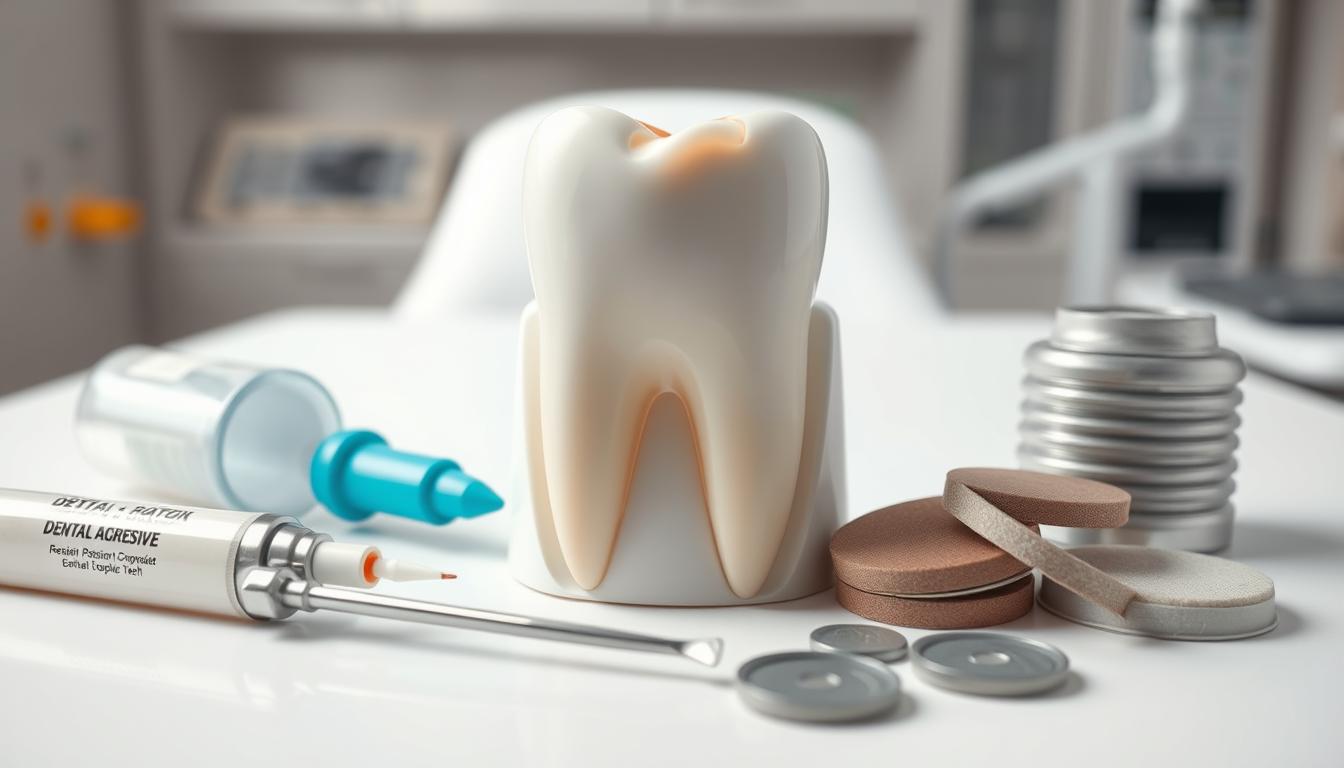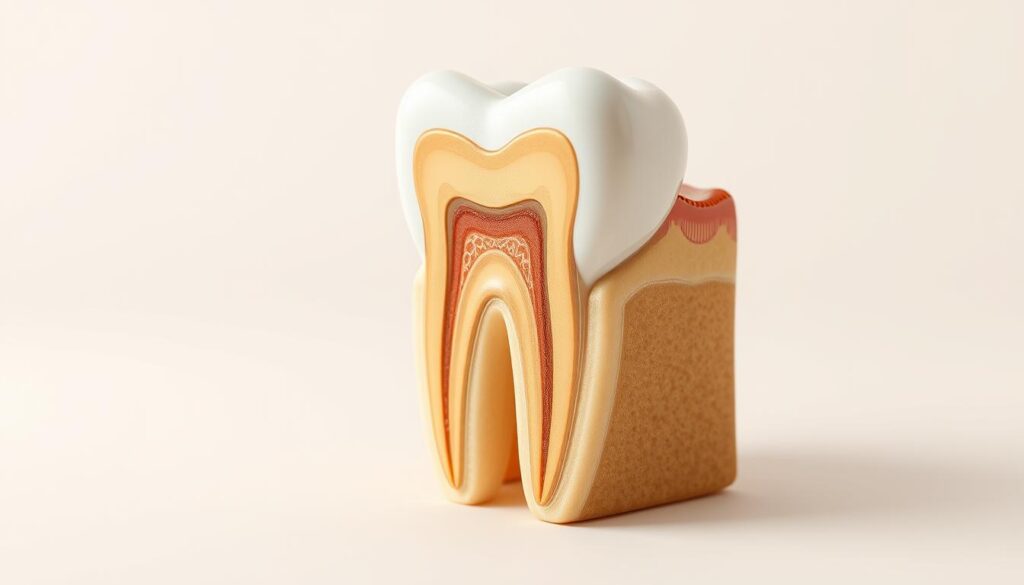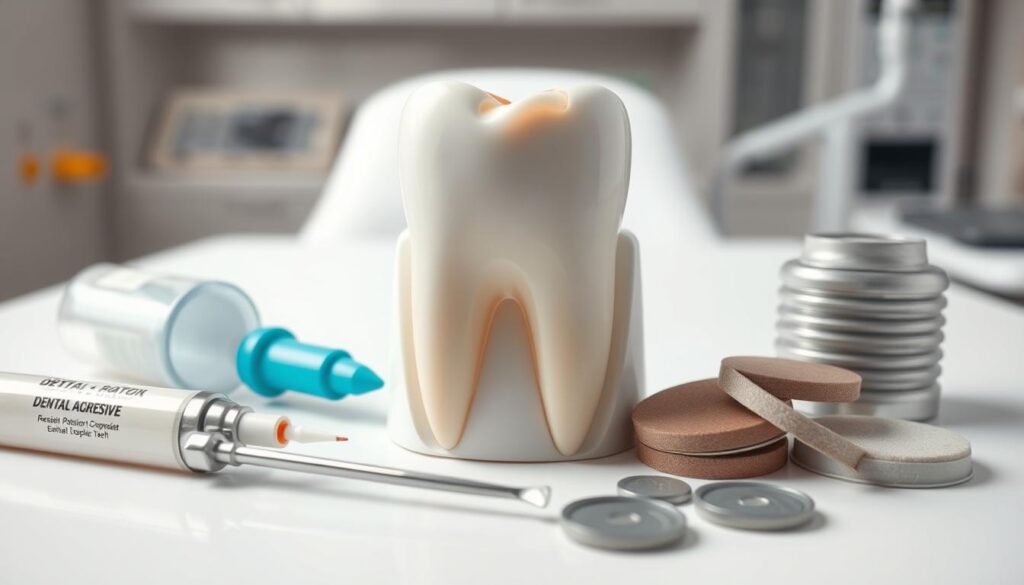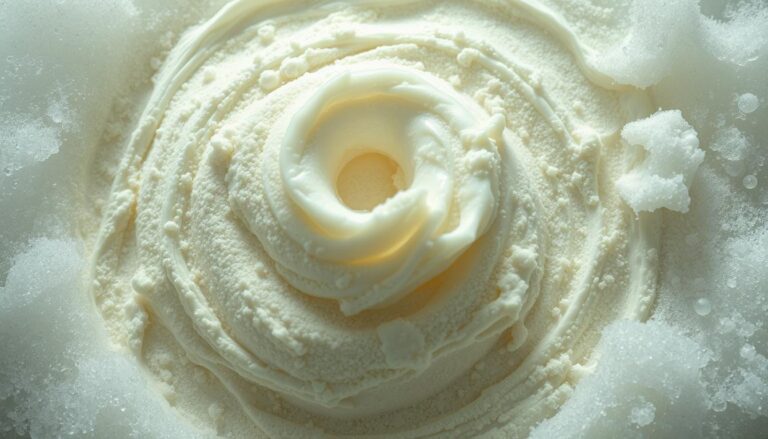Is a Chipped Adult Tooth Serious?

Every year, up to 20% of adults experience a chipped tooth or other dental injuries. Many of them wait before getting dental help. This delay can make a small problem much worse. So, is a minor chip in an adult tooth a big concern? Yes, it can be.
Enamel is the hardest substance in our bodies, but it’s not unbreakable. Even a small chip can expose the tooth’s weaker layers. This exposure can lead to sensitivity, more cracks, or bacteria getting in. The Cleveland Clinic says that dental accidents or biting something hard might mean you need polishing, bonding, or a crown. These steps can stop more damage and make your tooth work right again.
WebMD suggests getting a chipped tooth checked out right away to avoid pulp infection or losing the tooth. You can care for it at home with saltwater rinses and pain relievers. You can also cover sharp parts with wax. But, a dentist needs to check the damage’s size and seriousness. We want to help you know when a chip is nothing to worry about or when it’s a sign of bigger dental problems.
We will explain what teeth are made of, what causes dental accidents, and when to worry about small chips. You’ll learn how to recognize danger signs and the best treatments available, from cosmetic fixes to veneers. We also talk about how to prevent chips, the basics of dental insurance, and what to do in emergencies.
Key Takeaways
- Even a small chipped tooth can get worse, so seeing a dentist soon is smart.
- Is a small chip in an adult tooth a big deal? Often, yes—the depth and spot of the chip can risk your tooth.
- Teeth can get hurt from accidents or just daily habits.
- Checking a chipped tooth early can stop more sensitivity, cracks, and infection risks.
- Polishing, bonding, crowns, and veneers are proven fix options.
- Home care is okay for a bit, but a dentist must look at any tooth breaks.
- Knowing when it’s an emergency can stop extra problems.
Understanding Tooth Structure
Learning about the structure of adult teeth helps us understand why they can chip or crack. The outer part is strong but not invincible. The inside parts might hurt or swell if damaged. This knowledge helps dentists decide the best way to fix injured teeth.

The Anatomy of an Adult Tooth
The hardest part of our body is the tooth’s outer shell, called enamel. Even so, it can chip, especially on the edges or points.
Below the enamel is dentin. It’s not as hard and has tiny tubes. A chip can make this layer sensitive to hot and cold.
At the tooth’s core is the pulp, alive with nerves and blood vessels. If a crack reaches here, bacteria can cause inflammation or worse, leading to pulpitis or necrosis.
- Chip limited to enamel: often smooths or bonds well in a single visit.
- Chip into dentin: sensitivity increases and sealing becomes a priority.
- Exposure of pulp: urgent protection or endodontic care may be indicated.
Common Types of Tooth Injuries
Tooth injuries can be minor or severe. How deep and wide the break is affects the pain, risk of infection, and how it’s fixed.
| Injury Type | Tissue Involved | Typical Symptoms | Initial Clinical Aim | Usual Restorative Path |
|---|---|---|---|---|
| Small enamel chip | Enamel only | Sharp edge; little to no pain | Protect margins; restore form | Polishing or resin bonding |
| Enamel–dentin fracture | Enamel and dentin | Cold sensitivity; mild ache | Seal dentin; prevent bacterial entry | Bonding or onlay; evaluate occlusion |
| Complicated fracture | Dentin with pulp exposure | Throbbing pain; bleeding point | Protect pulp; control contamination | Pulp capping or root canal; crown for strength |
| Vertical cracked teeth | Crack through enamel and dentin | Bite pain; thermal flare-ups | Stabilize cusp; assess crack extent | Full-coverage crown; possible endodontics |
Tooth chipping is a complex issue. It ranges from simple enamel loss to serious breaks into the dentin or pulp. Matching the right treatment to the type of crack can save a tooth’s function and look while preventing more damage.
Causes of Chipped Teeth
Why do teeth chip? It can happen from sudden hits or from slow, constant stress. These cause tiny cracks that lead to chipped or even broken teeth. Knowing why this happens can help us prevent it and fix it quickly.
Accidental Trauma
Dental accidents often come from falls, missing a step, or hitting something at the gym. A hit to the face puts a lot of pressure on the thin edges of teeth. Wearing no mouthguard in sports raises the risk, turning a small hit into a damaged tooth.
- Falls on hard surfaces focus force on the tooth’s cutting edge.
- Getting hit by a ball or elbow in sports can harm enamel.
- Car or bike accidents put sudden, intense pressure that can break enamel.
Everyday Habits That Lead to Chips
Simple habits can slowly damage teeth over time. Biting hard things like ice or pens puts pressure on teeth. Teeth with decay or big fillings break easier, turning a small bite into a big problem.
- Don’t use teeth to open things or hold items.
- Try to stop grinding teeth; maybe get a nightguard if needed.
- Get old fillings fixed early to protect weak enamel.
Dietary Factors
Certain foods directly cause teeth to chip. Eating hard nuts or candies puts too much pressure on teeth edges. A hard bite on something like an unpopped popcorn kernel can chip teeth, especially if the enamel is thin.
- Hard foods put stress on the tips and edges of teeth.
- Acidic drinks make enamel softer, increasing risk of damage.
- Very cold or hard foods can make cracks worse.
Understanding the link between accidents, habits, and food helps us protect teeth. We can make mouthguards, suggest changes, and fix chips when they happen.
Is a Small Chip a Concern?
Many ask if a small chip in an adult tooth is a serious issue. Even a tiny chip can change how force moves through a tooth. Regular dental visits can check if the chip is okay or if it’s hiding bigger problems.
Assessment matters. A quick check, looking at how you bite, and x-rays help decide what to do next. Sometimes, all you need is to smooth the chip or strengthen the spot. This careful step keeps your teeth working right and healthy for a long time.
Potential for Further Damage
Chewing every day can make a small chip worse. Small cracks can grow, holding plaque and adding stress, which might lead to bigger cracks. To prevent this, dentists might polish tiny chips or use treatments that help spread out the force from biting.
Why fix it fast? Biting hard, changes in temperature, and teeth grinding can make small cracks worse. Acting quickly helps stop more damage, saves the tooth surface, and prevents deeper breaks.
- Minor polish: smooths edges and eases irritation.
- Resin bonding: seals exposed prisms and reinforces weak cusps.
- Occlusal guard: protects against bruxism-driven tooth chipping.
Impact on Tooth Sensitivity
Feeling sharp pain from cold or sweet things can mean exposed tooth parts or small cracks. If the tooth starts to look darker or heat bothers it, the inside part of the tooth might be under stress. Now, treating a small chip becomes about preventing risk and choosing the right dental treatment.
Treatment aims to cover exposed areas. Using fluoride varnish, special toothpaste, or fillings can help. If pain sticks around, a deeper check-up makes sure no serious damage has happened and sets up the best care plan.
Signs You Need to See a Dentist
A chipped tooth isn’t just about looks. It can signal a dental emergency, especially after an injury. Getting to a dentist quickly can save the tooth and keep nerves healthy. This also lowers the chance of bigger problems later.
Not sure what to watch for? Be on the lookout for new pain, feeling too hot or too cold, and changes in color near the break. If the tooth feels sharp, use orthodontic wax or sugarless gum to protect it until you see a dentist.
Symptoms of an Infected Tooth
- Persistent, throbbing pain that gets worse when you eat or drink something hot.
- Sudden sensitivity to temperatures after getting a tooth chipped.
- A tooth turning dark or gray, signaling damage inside.
- Gum swelling, a sore like a pimple, or tasting something foul.
- Fever or swollen spots near your jaw after hurting your tooth, which could mean an emergency.
These warnings mean the tooth’s inner part might be irritated or infected. Seeing a dentist right away can stop things from getting worse and might save the tooth.
Importance of Monitoring Changes
Keep track of how things change each day. Note any differences in sensitivity, color, or how biting feels. These details help your dentist figure out if the nerve could be in danger.
- Protect the tooth: use wax or gum to prevent further injury.
- Avoid food that’s too hot or too cold to reduce discomfort.
- Quick actions: pain, swelling, or color changes mean you should see a dentist immediately to avoid worse issues.
| Warning Sign | What It Suggests | At-Home Step | When to Seek Care |
|---|---|---|---|
| Heat sensitivity after a chipped tooth | Pulp irritation or exposure | Use wax on sharp areas; avoid hot drinks | Within 24 hours if persistent or worsening |
| Darkening or gray color | Nerve damage from an injury | Keep an eye on it; don’t chew hard food | See a dentist as soon as you can |
| Throbbing pain and swelling | Probably an infection | Cool it down; take painkillers if needed | Visit the dentist quickly to handle the emergency |
| Sharp edge cutting soft tissue | Broken enamel or inner tooth | Cover with gum or wax | Get it checked quickly for repair |
Treatment Options for Chipped Teeth
A chipped tooth might be minor or show deeper damage. The repair needed, like bonding, crowns, or veneers, depends on its size, place, and if the enamel or dentin is seen. Starting with a full checkup helps tell apart a small chip from serious damage needing more protection.

Cosmetic Bonding
Cosmetic bonding works well for small chips. The dentist makes the tooth’s surface rough, applies glue, adds a tooth-colored composite, shapes it, and uses UV light to harden it. It’s fast, often needs no numbing, and one visit is usually enough.
It looks like natural teeth and improves the tooth’s shape. It’s good for front teeth or small breaks. But it can get worn or stained over time, so taking care of it is key.
Dental Crowns
For big chips or after decay, crowns bring back strength and use. Options include tough metal, metal with porcelain for looks and strength, ceramic for looks, and resin to save money.
Getting a crown usually needs two visits: first, to prepare the tooth and make models or scans. Then, after wearing a temporary crown, you get the final one in 2–3 weeks. Some places make crowns the same day. If the tooth’s pulp is hurt, you might need a root canal first.
Veneers: A Long-Term Solution
Veneers are great for fixing the look of front teeth. They cover the tooth with thin porcelain or composite. Usually, a little enamel is removed before making models and putting on the veneer with a special light, often done in 1–2 weeks.
Veneers can hide color issues and fix shapes without removing much tooth. To make them last, take good care of your teeth and use a night guard if you grind them.
| Option | Best For | Procedure Time | Longevity | Key Advantages | Considerations |
|---|---|---|---|---|---|
| Cosmetic Bonding | Small enamel chips; minor broken tooth repairs | Single visit; often under 60–90 minutes | 3–7 years, depending on wear | Conservative, affordable, immediate results | More prone to staining and chipping than porcelain |
| Dental Crowns | Large structural loss; cracked teeth with functional risk | Two visits (2–3 weeks) or same‑day CAD/CAM | 10–15+ years with proper care | Full‑coverage strength, protects weakened tooth | More tooth reduction; may require root canal if pulp is compromised |
| Veneers | Front‑tooth esthetics; shape and color correction | 1–2 weeks after preparation and impression | 10–15+ years for porcelain | Highly natural appearance, minimal removal compared with crowns | Not ideal for heavy bite forces or untreated bruxism |
- Tip: A quick checkup can tell a simple chip from a worse cracked tooth risk.
- Keep up with dental care, use a soft brush, and gentle toothpaste to protect your fixed tooth.
- A night guard might help if grinding affects your bonding, veneers, or crowns.
Preventive Measures for Tooth Chips
Strong enamel begins with daily routines and smart choices for protection. Making a plan for dental care helps avoid tooth chips and eases the impact of dental mishaps. The little choices we make, like what we eat, how we brush, and wearing guards, affect our teeth long term.
Good Oral Hygiene Practices
Plaque acids can weaken enamel if not removed. Brushing twice a day with fluoride toothpaste and flossing nightly can prevent chips. A soft toothbrush keeps the enamel solid.
Be mindful of your diet. Avoid ice, hard candies, and unpopped popcorn kernels. Don’t use your teeth as tools. These steps help avoid chipping when you eat daily.
- Go for exams and cleanings every six months to spot early signs of cracks.
- Fix old fillings or issues with heavy biting to prevent breaks.
- If you grind your teeth at night, think about getting a custom night guard.
Protective Gear for Sports
Sports, especially those with contact, increase dental injury risks. A proper mouthguard spreads out the force of a hit, making chips less likely and protecting teeth.
Choosing the right fit and material matters. Basic guards offer little adjustment, while special boil-and-bite ones fit better. Custom guards from a dentist are best for preventing chips and stay put best.
| Mouthguard Type | Protection Level | Best Use Case | Pros | Considerations |
|---|---|---|---|---|
| Stock (Pre-formed) | Basic | Occasional play, low-impact sports | Low cost; immediate availability | Loose fit; reduced speech and breathing comfort |
| Boil-and-Bite | Moderate | Recreational leagues; teens in training | Improved adaptation; affordable | Fit varies with technique; may thin in high-stress areas |
| Custom (Dental Lab) | High | Contact sports; athletes with restorations or braces | Precise fit; durable multilayer design | Higher cost; requires dental visit |
Bottom line: Regular dental care, wise choices with food, and using the right gear for sports can all help reduce the risk of tooth chipping and minimize the damage from dental accidents.
When to Seek Emergency Dental Care
Reacting quickly and smartly after a dental accident can save a tooth. Not all chipped teeth are emergencies. But for some, immediate action is crucial to save the tooth, ease pain, and stop infection.
Which situations cannot wait? If you have a seriously broken tooth, can’t stop the bleeding, or a tooth is knocked out, you need urgent care. Taking the right steps at home can really help before you get professional care.

Understanding Dental Emergencies
If an adult tooth is knocked out, time matters. Only touch the crown, not the root. Rinse it briefly with lukewarm water if it’s dirty. Try to put it back in its place, or keep it in milk or your cheek.
Stop bleeding by pressing with gauze. Use a cold pack for swelling. If your tooth is chipped or broken but not out, call your dentist fast. Take acetaminophen or ibuprofen for the pain, and rinse your mouth with warm saltwater to calm irritation.
- Do not scrub the root surface or use soap or alcohol.
- Avoid aspirin directly on gums; it can cause burns.
- Preserve fragments from teeth injuries for possible reattachment.
What to Expect at the Dental Office
The dental team will check your accident history and look at your soft tissues and tooth health. X-rays can show more about roots and bones. The findings help plan a careful treatment.
Small chips usually get a bond or filling to protect the tooth. Big chips may need a temporary cover before getting a crown or veneer. If the pulp is hurt, you might need special care to save the tooth before it’s fixed for good.
| Scenario | Immediate Steps | Likely Office Evaluation | Common Treatments |
|---|---|---|---|
| Knocked-out permanent tooth (avulsion) | Handle by crown, brief rinse, reinsert or store in milk/cheek, apply gauze, seek urgent care | Vitality testing, periapical X‑rays, periodontal assessment | Reimplantation, stabilization splint, possible root canal therapy |
| Chipped tooth without severe pain | Call dentist, save fragments, saltwater rinse, OTC analgesic | Caries check, fracture mapping, bite analysis | Cosmetic bonding or enamel contouring; monitor |
| Broken tooth with sensitivity or bleeding | Gauze pressure, cool compress, analgesic, avoid hard biting | Pulp exposure evaluation, radiographs, soft‑tissue exam | Temporary restoration, crown planning, or endodontic care as needed |
| Soft‑tissue injury from dental accidents | Rinse gently, pressure for hemostasis | Laceration inspection, foreign‑body check on X‑ray | Suturing if indicated, tetanus review, wound care instructions |
The Role of Dental Insurance
Planning ahead can save you from unexpected bills. Dental insurance affects what you pay, by how it views different treatments. Knowing your plan can help you manage costs when urgent care is needed.
Coverage for Dental Injuries
Dental plans usually tell apart trauma repair from beauty choices. If you chip a tooth, fixing it can be covered, but a veneer for looks might not be. A crown gets more support than a veneer since it’s about function, not just shape or color.
How soon you get treatment can also impact coverage. Quick fixes like bonding are simple, but crowns or root treatments have more steps. Choosing clinics that offer same-day crowns can lower your overall costs and hassle, without affecting your coverage.
- Check if coverage for crowns and root canals due to fractures differs from that for decay.
- See if accidents get special treatment when it comes to emergency care reimbursement.
- Know the waiting periods, limits on how often you can get care, and discounts before making plans.
For advice on what to do if your tooth breaks, see this guide. Then, match what your dentist suggests to what your plan covers.
Understanding Out-of-Pocket Costs
Figure out your share of the cost by looking at deductibles, coinsurance, and caps. Only repair work counts here, not prevention. If your benefits reset soon, timing your care could save you money over the year.
| Scenario | Typical Care Path | Insurance Position | Cost Drivers to Watch |
|---|---|---|---|
| Small enamel chip | Single-visit bonding or smoothing | Often covered as basic restorative | Deductible, basic coinsurance, remaining annual maximum |
| Fracture with pain | Root canal therapy + crown | Endodontics and crown commonly covered when due to fracture | Major coinsurance, multi-visit fees, lab costs, post/core billing |
| Cosmetic veneer choice | Veneer for esthetics on intact tooth | Limited or excluded as elective | Full patient pay; financing or phased care |
| Same-day crown option | Digital scan and in-office milling | Crown covered per policy; visit count reduced | Plan allowance vs. office fee, time savings, fewer temp-related issues |
Always ask for a pre-authorization to know the costs upfront. Make sure your tests, temporary care, and final treatment fit within your insurance limits. This way, you ensure timely care and solid coverage for dental emergencies.
Myths About Chipped Teeth
People often mix up science with old wives’ tales. We’ll clear up myths about chipped teeth, showing what helps or harms them. Whether a small chip in an adult tooth matters depends on its depth and location, and how you use your teeth. It’s key to assess it properly.
Debunking Common Misconceptions
Myth: “A small chip is purely cosmetic.” A tiny chip can lead to big problems. It can let bacteria reach deeper parts of the tooth. Even mild pain can get worse when you chew, leading to more damage. Fixing it early with smoothing or bonding stops worse damage.
Myth: “Enamel is indestructible.” Though enamel is super strong, it can still break. Eating hard foods, finding hidden stones in meals, or decay can cause it to crack. Keeping teeth healthy with fluoride and prompt repairs can stop chips from happening.
- Small chips might only need polishing after checking the risk.
- Chips on tooth edges where you bite hard usually need bonding.
- Big cracks might need special covers or crowns to protect the tooth.
Why You Shouldn’t Ignore a Chip
Is a small chip in a tooth a big issue? Waiting too long can turn a simple fix into a big procedure. Acting quickly helps save the tooth at a lower cost.
| Myth | Reality | Recommended Next Step | Potential Risk If Ignored |
|---|---|---|---|
| Small chips don’t matter | Edges can fracture further and trap plaque | Exam, polish or bonding to seal and reinforce | Crack propagation, sensitivity, infection |
| Enamel won’t break | Brittle enamel fails under high stress or decay | Bite check, fluoride, repair of weak spots | Larger fractures requiring crowns |
| No pain means no problem | Early pulp irritation may be silent | Diagnostic tests and monitoring | Costly root canal or tooth loss |
| Home fixes are enough | DIY smoothing can worsen damage | Professional dental care with sterile tools | Infection, uneven bite, ongoing wear |
Combining accurate diagnosis with quick dental action keeps a chipped tooth healthy and looking good. A careful plan, based on facts and skilled techniques, clears up any doubts.
How to Manage Pain After a Chip
Chipped tooth pain can feel like a mild sting or sharp throbs. Taking early steps at home can help reduce the pain and risk until you see a dentist. These simple actions can control pain and protect your tooth’s enamel and soft tissues.
Home Remedies for Tooth Pain
Begin with over-the-counter pain relief. Acetaminophen or ibuprofen can lessen the pain and reduce swelling. Using a warm saltwater rinse can clean the area and support oral health.
If the tooth’s edge feels sharp, use wax paraffin or sugarless gum to protect your cheek and tongue. Eat soft foods and avoid cold drinks. Also, try not to bite down on the injured side. Remember, these are temporary solutions and can’t replace professional care if the pain continues.
- Rinse gently after meals to clean debris around the chip.
- Use a desensitizing toothpaste to minimize sensitivity from the exposed dentin.
- Keep your head elevated when sleeping to lessen throbbing at night.
When Pain Indicates a Larger Issue
Be on the lookout for signs of a dental emergency. If pain lasts more than a day or two, gets worse, or increases with heat, this could mean the problem is serious. A dark tooth or swollen gums could also mean deeper damage.
Getting urgent help can prevent infections from spreading. A dentist might suggest a root canal to treat diseased pulp and protect the tooth. Getting timely treatment is key to avoiding further damage to the tooth.
| Symptom Pattern | Likely Cause | Immediate Action | Next Step |
|---|---|---|---|
| Brief sensitivity to cold or air | Exposed dentin from chip | Use desensitizing paste; saltwater rinse | Schedule non-urgent visit within a few days |
| Chipped tooth pain that worsens with heat | Pulp irritation or inflammation | Ibuprofen if appropriate; avoid chewing on tooth | Seek urgent exam for possible root canal therapy |
| Persistent throbbing tooth pain with gum swelling | Pulpal infection or abscess | Do not apply aspirin on gum; cold compress on cheek | Same-day dental emergency assessment |
| Sharp edge cutting cheek or tongue | Enamel fracture with rough margin | Cover with wax paraffin or sugarless gum | Prompt smoothing, bonding, or interim protection |
Long-Term Effects of Untreated Chips
At first, small fractures may not seem like a big deal. But over time, they can become serious. They let in bacteria, weaken your tooth, and make your bite off. Taking care of your teeth early keeps them working well and feeling good.
Risks of Ignoring a Chipped Tooth
A small chip can grow into a big crack. Stress around the chip can cause the tooth to flex when you chew. This can make the tooth split even more, sometimes below the gum.
If bacteria gets into the tooth, it can cause a lot of pain and might kill the tooth. You might need a special treatment to save it. If it’s really bad, you might lose the tooth or need a big cap.
A chipped tooth can mess up how your teeth fit together. This puts extra wear on the teeth around it. Over time, this can cause more chips and sensitivity.
How to Avoid Complications
Checking your teeth early can save you from bigger problems. Small fixes or bonding can protect your teeth. If a crack gets too deep, a root canal and a crown can help.
What you do every day can also help. Don’t chew on hard things. Brush and clean between your teeth well. Using fluoride can also help keep cracks from getting worse. Check out this guide for tips on avoiding tooth breaks.
- Timely assessment: Schedule a prompt exam and radiographs to map the crack path.
- Conservative restoration: Choose polishing or bonding for small defects; escalate only as needed.
- Bite protection: Use a night guard if clenching or grinding threatens cracked teeth.
- Hygiene upgrades: Add interdental brushes and remineralizing paste to daily dental care.
| Clinical Scenario | Primary Risk | Recommended Action | Expected Outcome |
|---|---|---|---|
| Enamel chip without pain | Surface roughness, plaque retention | Polish or bonding; monitor | Smoother surface, reduced bacteria, stable function |
| Chip with cold sensitivity | Dentin exposure, crack propagation | Bonding or onlay; occlusal adjustment | Sealed tubules, lower sensitivity, controlled forces |
| Visible crack lines and biting pain | Pulp inflammation, structural failure | Endodontic therapy and crown | Eliminated infection, reinforced tooth |
| Deep fracture below gumline | Vertical split, poor prognosis | Extraction and implant or bridge | Restored function with stable prosthesis |
The Importance of Regular Dental Checkups
Dental checkups help catch problems early. They find tiny cracks and early decay before things get worse. This early action prevents bigger issues and makes fixes easy and precise.
Why wait for pain to speak when careful screening can whisper the first warning? The Cleveland Clinic highlights personalized plans that fit each patient’s needs and goals. Our dental care combines thorough exams with advice that fits into your daily life.
How Checkups Help Prevent Issues
Dentists use special exams to spot cracks and signs of teeth grinding. They polish teeth and apply treatments to make teeth stronger. This helps prevent chips and keeps teeth natural.
- Advanced imaging spots problems under old fillings.
- Bite analysis helps find grinding issues and design nightguards.
- Regular cleanings fight plaque and protect enamel.
This resource helps understand if a broken tooth can heal on its own. It guides discussions and decisions about treatment.
What to Discuss During Your Visit
Talk openly about your dental habits and any symptoms. This helps create a full and effective dental care plan.
- Discuss any habits like grinding teeth or chewing on hard objects.
- Mention if you’ve had any falls, sports injuries, or jaw pain.
- Talk about any sensitivity to cold, sweets, or when biting.
- Consider restoration options like bonding, crowns, or veneers.
- Ask about imaging needs for suspected cracks.
- Explore protection like mouthguards for sports.
Discussing your lifestyle, diet, and home care wraps up your dental care plan. Making small changes, like wearing a night guard or smoothing a tooth’s edge, prevents chips. This makes your dental visits easier and quicker in the future.
Emotional Impact of Chipped Teeth
A visible chip can alter a person’s smile both in pictures and daily interactions. This often leads to habits like hiding the mouth or dodging social gatherings. Fixing these dental issues early can enhance well-being and bring back a sense of control.
Boosting Self-Confidence After a Chip
Minor enamel damages can be smoothed or polished in a quick visit. This helps lessen the look of a chipped tooth and reduces worry. For bigger chips, cosmetic bonding uses a tooth-colored resin to fix the shape and symmetry. Patients say these fixes help make speaking and smiling feel easier.
Veneers offer a longer-term change with a natural look for those who want more. Thin porcelain shells are put on teeth after a small enamel prep. They’re stuck on with a special glue and light. This method is a mix of function and beauty, meeting people’s needs.
Coping with Aesthetic Concerns
Emotional stress may increase when your smile doesn’t fit your self-view anymore. Planning the choice between cosmetic bonding and veneers helps make things clear. It aids in making choices by ensuring treatments match in color, texture, and size to reduce worries about how teeth look while keeping them healthy.
Here are practical tips for everyday:
- Choose lip balm with soft colors to less spotlight a chipped tooth.
- Try short smile exercises to get comfortable in social spots again.
- Talk about color matching and finishes with your dentist to make sure bonding or veneers look right with your other teeth.
With plans focused on the patient and open talks, choices in treatment can match both needs and identity. This helps confidence grow as smiles get back to looking full and lively.
Chipped Teeth in Children vs. Adults
A chipped tooth may look the same whether it’s in a child or an adult. However, differences exist due to age, risks, and how teeth grow. It’s important to choose the right dental care, whether it’s for a child or an adult, especially after an injury.
Differences in Treatment Approaches
Adult teeth are fully grown, so dentists can make permanent repairs. They might use bonding for small chips or crowns and veneers for bigger issues. They think about how the teeth fit together and what the teeth have been through before, picking materials like porcelain or metal.
For kids, the goal is to keep the tooth alive and healthy as it grows. Small chips might only need some smoothing or a bit of resin to fix. If a permanent tooth gets knocked out, it needs fast action to put it back. But baby teeth don’t get put back in to avoid harming the new teeth coming in.
- Adult goals: restore function, stabilize bite forces, and achieve long-term esthetics.
- Pediatric goals: safeguard developing tissues, limit invasive steps, and keep options open as jaws grow.
The Importance of Monitoring Growth
Since kids’ jaws and faces change fast, treatments need to keep up with their growth. Regular dentist visits help make sure everything is still fitting right. These visits help decide if and when a temporary fix should become permanent.
In adults, changes happen more slowly, but keeping an eye on things is still crucial. Things like teeth grinding, diet, or new injuries could change how well treatments work. Regular check-ups help keep the repaired area and nearby teeth safe.
| Clinical Factor | Children | Adults |
|---|---|---|
| Tooth/Facial Growth | Active; eruption and jaw growth influence restoration timing. | Complete; stable references allow definitive treatment. |
| Preferred Restoration | Conservative resin bonding; provisional solutions until growth stabilizes. | Bonding for minor defects; crowns or veneers for structural loss. |
| Occlusal Considerations | Occlusion evolving; frequent adjustments expected. | Established occlusion; material chosen for load and wear. |
| Emergency Response | Avulsed permanent teeth: urgent reimplantation guidance; primary teeth not reimplanted. | Immediate stabilization and pulpal assessment; definitive repair as indicated. |
| Follow-Up Interval | Shorter intervals to track eruption, vitality, and growth changes. | Routine intervals; targeted checks for wear, fractures, and margins. |
| Risk of Over-Treatment | High; invasive steps can harm developing tissues. | Lower; definitive choices balance strength and esthetics. |
Recovery and Aftercare
Recovery from a chipped tooth involves science-based steps. Making smart choices early on can protect the new dental work and lessen sensitivity. It’s also key to have simple daily dental care routines to make repairs last.
Caring for a Chipped Tooth Post-Treatment
After you get bonding or fillings, don’t bite on hard things like pens, ice, or nutshells. This helps keep the resin strong and the edges smooth. Rinse with warm saltwater for comfort, and take over-the-counter pain relievers as the label directs if you need them.
If you’re getting a crown, you might have a temporary one for 2-3 weeks, unless it’s made the same day. To protect it, eat on the other side of your mouth and avoid sticky or hard foods. The final crown’s durability and look will depend on its material—ceramic, zirconia, or a mix of metal and ceramic.
Veneers mean removing a tiny bit of enamel and attaching them with a special light-activated cement. Wear a night guard if you grind your teeth to protect the veneers. And be gentle when opening things with your teeth. Following these steps will help your treatment last and keep your teeth healthy.
Keep your teeth clean with a soft toothbrush and gentle toothpaste. Floss carefully to avoid plaque build-up around the restored area. If you notice sensitivity or it doesn’t go away after a few days, call your dentist.
Dietary Restrictions for Healing
For the first few days, eat soft foods like yogurt, scrambled eggs, oatmeal, and soft-cooked veggies. Chew on the side of your mouth away from the dental work. This helps avoid discomfort and movement of the new restoration.
Stay away from sticky sweets, hard candies, ice, and tough nuts. Don’t bite into hard foods like apples or crusty bread directly with the treated tooth. Cut your food into small pieces to ease the pressure on your tooth.
Avoid drinks that are very hot or cold if they make your teeth sensitive. Drink water between meals to keep your mouth’s pH balanced. Check how you’re feeling after a week and slowly get back to your usual diet as you feel better.
- Key reminders: start with soft foods, chew on the other side, skip sticky/hard foods, and clean gently.
- Keep an eye on any changes in pain or swelling, and see a doctor if things don’t improve.
Frequently Asked Questions
When a dental emergency like a chipped tooth happens suddenly, people look for clear advice. This FAQ gives you the steps you need for tooth injuries. It also points you to resources you can trust, so you know exactly what to do.
Common Queries About Chipped Teeth
Should you treat small chips right away? Yes, even minor chips can be serious. They might need polishing or bonding after a dentist looks at them. A quick check can stop further damage and keep your bite safe.
Is feeling pain normal? Yes, it’s common to feel some sensitivity. But if you feel sharp pain from heat, see discoloration, or have a lasting ache, the tooth’s pulp might be damaged. This needs quick attention from a dentist.
What if you knock out a tooth? This is urgent. Only touch the top part of the tooth, try to put it back if you can. If not, keep it in cold milk or in your cheek and get help right away. The quicker you act, within 30 minutes is best, the greater the chances of saving the tooth.
Getting crowns or veneers takes time. Crowns need about two visits spread over 2–3 weeks. But with modern same-day machines, it can be faster. Veneers usually need one visit to get ready, then 1–2 weeks for the lab to make them.
Resources for Additional Information
If you need answers fast for a chipped tooth, help is available. In the US, you can talk to a local dentist, visit an emergency department for serious cases, or call your insurer’s nurse line for advice. In some areas like British Columbia, you can get free advice over the phone through numbers like 8-1-1 or 7-1-1 for those who are deaf or hard of hearing.
Follow this checklist to make smart choices when dealing with tooth injuries and their care.
| Situation | Immediate Action | Clinical Rationale | Who to Contact |
|---|---|---|---|
| Small enamel chip | Rinse, save fragments, avoid hard foods | Prevents propagation and preserves bonding options | General dentist for assessment within 24–72 hours |
| Sensitivity to heat or persistent pain | Use OTC analgesics as directed, avoid extremes of temperature | May indicate pulpal inflammation or crack extension | General dentist or endodontist as soon as possible |
| Tooth knocked out (avulsion) | Reinsert or place in milk/cheek; do not scrub root | Maintains periodontal ligament cell viability and improves outcomes | Emergency dentist or hospital emergency department immediately |
| Large fracture with sharp edges | Cover edge with dental wax; avoid biting on the tooth | Reduces soft-tissue injury and limits further structural loss | General dentist or oral surgeon urgently |
| Crown or veneer timeline | Schedule prep and follow-up; ask about same-day CAD/CAM | Aligns expectations for 2–3 weeks (crowns) or 1–2 weeks (veneers) | Restorative dentist with lab or in-office milling capability |
| Guidance outside office hours | Call insurer nurse line or local on-call dentist | Provides triage for urgent versus routine care | Insurance support line; regional health information services |
These tips answer the most common questions about chipped teeth and provide guidance for dental emergencies. Keep this info close and reach out to local experts to make wise decisions in these situations.
Conclusion: Addressing Your Concerns
Breaking an adult tooth, even with a small chip, is important. A small chip can open up the dentin to bacteria. This increases the risk of more breaks or irritation inside the tooth. Quick fixes like polishing or bonding can solve many issues. Still, waiting too long could make things worse. We aim to keep your teeth healthy, looking good, and strong.
Making Informed Decisions About Dental Health
Making smart choices begins with a detailed exam. Your dentist looks for cracks, checks the enamel, and tests for sensitivity. They consider your smile and what you want to achieve. You might need bonding, a crown, veneers, or even a root canal followed by a crown. To ease pain and prevent further damage, use pain relievers, rinse with saltwater, cover sharp edges, and eat soft foods.
Seeking Professional Guidance
For a chipped tooth, see your dentist right away. Treat knocked-out teeth as emergencies; keep them in milk and get help. Your final treatment plan will depend on what the dentist finds and your insurance. Starting early with the right care means small issues don’t get big. This way, your teeth stay functional, comfortable, and looking good.


